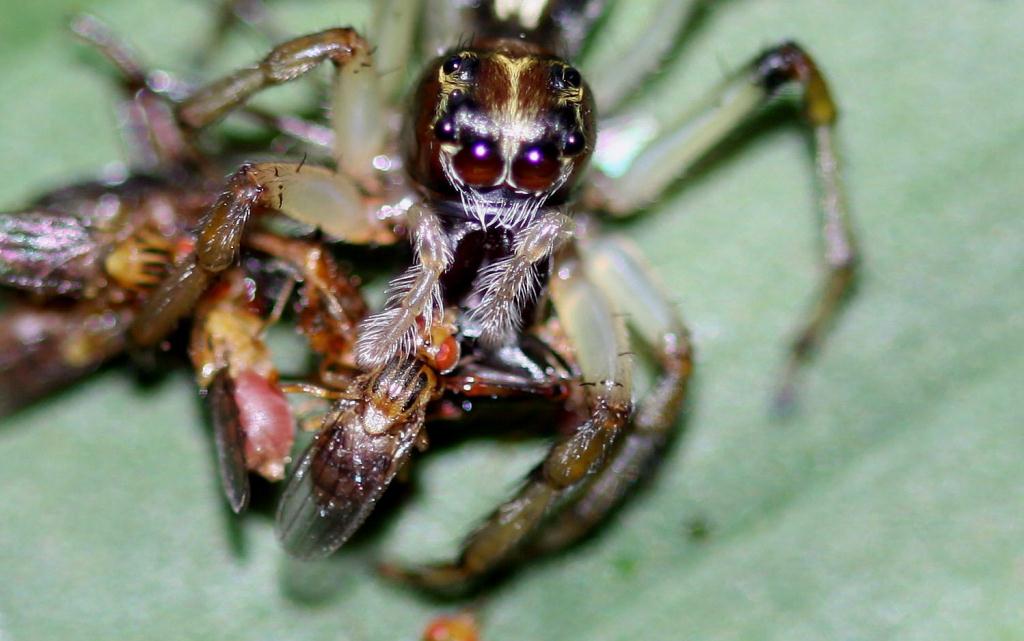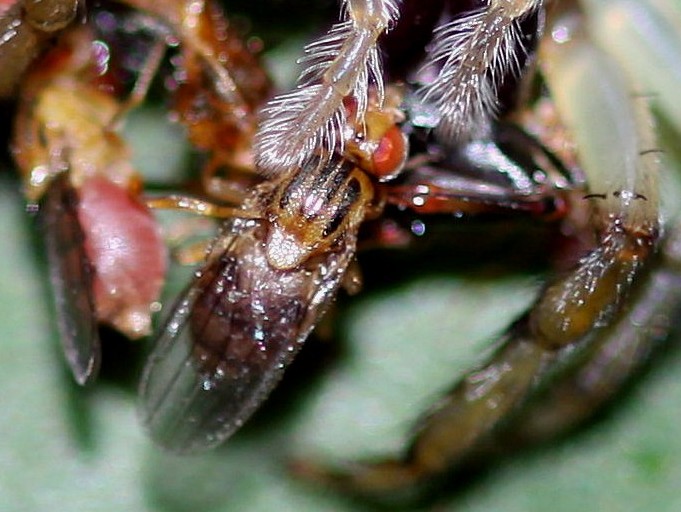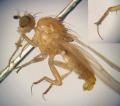Diptera.info :: Identification queries :: Diptera (adults)
|
Tiny Brazilian flies on zebraspider prey..
|
|
| bonitin |
Posted on 16-12-2010 16:38
|
|
Member Location: Gent, Belgium Posts: 348 Joined: 11.10.07 |
Hi, I am very curious what these tiny flies with the size of fruitflies could be so interested in the unfortunate prey of the zebraspider, not fearing the spider, I have seen these flies also on other occasions like on the prey of a huge robberfly. Very strange..any chance for a family or genus name? Thank you! Myriam  Botanical garden Rio de Janeiro, January 2010 bonitin attached the following image:  [114.34Kb] |
|
|
|
| bonitin |
Posted on 16-12-2010 16:40
|
|
Member Location: Gent, Belgium Posts: 348 Joined: 11.10.07 |
...
bonitin attached the following image:  [123.67Kb] |
|
|
|
| Sara21392 |
Posted on 16-12-2010 16:56
|
|
Member Location: Posts: 1445 Joined: 07.11.10 |
Looks like to Chloropidae...
Edited by Sara21392 on 16-12-2010 16:58 Sincerely yours Sara |
|
|
|
| bonitin |
Posted on 16-12-2010 17:04
|
|
Member Location: Gent, Belgium Posts: 348 Joined: 11.10.07 |
Thanks Sara! Any idea why they are interested in the spider's prey? |
|
|
|
| Sara21392 |
Posted on 16-12-2010 17:28
|
|
Member Location: Posts: 1445 Joined: 07.11.10 |
I don't have species idea, but if it be Chloropidae, I just know that [some] species of Chloropidae interested to the secretion fluid that exit from body, maybe that such things...I await for suitable answer...
Sincerely yours Sara |
|
|
|
| cyprinoid |
Posted on 16-12-2010 19:17
|
|
Member Location: Norway Posts: 1751 Joined: 19.06.09 |
Milichiidae are know for this behaviour, but I can't tell them apart from Chloropidae  Edit: http://milichiidae.info/ Edited by cyprinoid on 16-12-2010 19:29 Hyperbolizer |
| Sara21392 |
Posted on 16-12-2010 19:52
|
|
Member Location: Posts: 1445 Joined: 07.11.10 |
Thank you very much for your inform; But this behavior in Chloropidae is, too; For example: Siphunculina or Hippelates…and a few species that now I don’t remember (if remember it, I’ll tell you), have such behavior, which in some that species, even maybe cause disease in human…  Sincerely yours Sara |
|
|
|
| Tony Irwin |
Posted on 16-12-2010 22:09
|
|
Member Location: Norwich, England Posts: 7327 Joined: 19.11.04 |
Gaurax and Trachysiphonella are two genera of chloropids that have been observed feeding on crab spider prey.
Tony ---------- Tony Irwin |
|
|
|
| Sara21392 |
Posted on 17-12-2010 09:00
|
|
Member Location: Posts: 1445 Joined: 07.11.10 |
Thank you Tony! 
Sincerely yours Sara |
|
|
|
| bonitin |
Posted on 17-12-2010 13:25
|
|
Member Location: Gent, Belgium Posts: 348 Joined: 11.10.07 |
Thank you all for the info! It is still mysterious though why they only feed on the prey when caught by a predator. It is creepy and they look so innocent!  |
|
|
|
| ibrake |
Posted on 09-03-2011 12:43
|
|
Member Location: Posts: 64 Joined: 03.03.08 |
If the prey are Heteroptera, the flies are attracted by the chemicals in the defensive spray of the bugs. |
| Sara21392 |
Posted on 14-12-2011 16:50
|
|
Member Location: Posts: 1445 Joined: 07.11.10 |
Hi Myriam I don't know you still are curious about this subject or you found any answer about, (of course I'll be glad if you advise me about result that you found)  , anyway I thought maybe interesting for you if you look at this http://www.fcla.e...82p179.pdf! , anyway I thought maybe interesting for you if you look at this http://www.fcla.e...82p179.pdf! 
Sincerely yours Sara |
|
|
|
| von Tschirnhaus |
Posted on 09-04-2020 15:47
|
|
Member Location: Bielefeld, Germany Posts: 454 Joined: 04.11.07 |
Chloropidae, Oscinellinae, Tricimba sp. Tricimba Lioy, 1864 is one of the most species rich genus in Chloropidae, 197 valid species are known. Three impressed longitudinal lines on the scutum are peculiar along which the acrostichal setulae are criss-cross orientated. Many Tricimba species visit predatory arthropods to suck the liquidated prey. An article on kleptoparasitism of Chloropidae: Tschirnhaus, M. von, Borkenstein, A. & Jödicke, R. 2015. Lestes dryas (Odonata: Lestidae) und kommensalische Fliegen (Diptera: Chloropidae), mit einer Übersicht über Kleptoparasitismus bei Halmfliegen. [Lestes dryas (Odonata: Lestidae) and commensalic flies (Diptera: Chloropidae), with an overview on kleptoparasitism of frit flies]. Mercuriale 12 (2014): 1-12; Karlsruhe. |
| Jump to Forum: |













